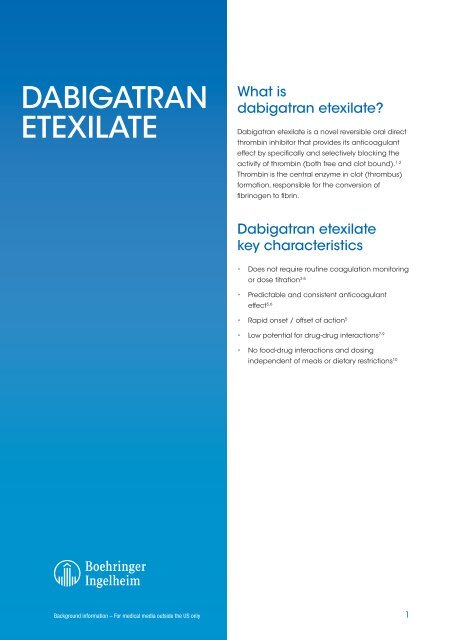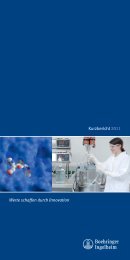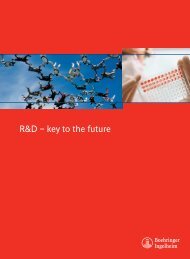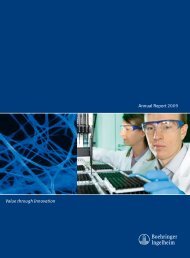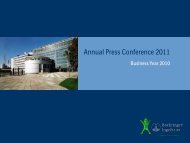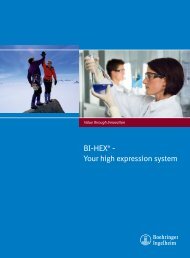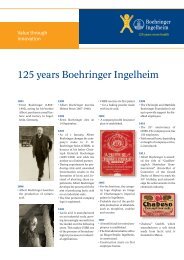Dabigatran etexilate - 2010 - PDF - Boehringer Ingelheim
Dabigatran etexilate - 2010 - PDF - Boehringer Ingelheim
Dabigatran etexilate - 2010 - PDF - Boehringer Ingelheim
Create successful ePaper yourself
Turn your PDF publications into a flip-book with our unique Google optimized e-Paper software.
<strong>Dabigatran</strong><br />
<strong>etexilate</strong><br />
Background information – For medical media outside the US only<br />
What is<br />
dabigatran <strong>etexilate</strong>?<br />
<strong>Dabigatran</strong> <strong>etexilate</strong> is a novel reversible oral direct<br />
thrombin inhibitor that provides its anticoagulant<br />
effect by specifically and selectively blocking the<br />
activity of thrombin (both free and clot bound). 1,2<br />
Thrombin is the central enzyme in clot (thrombus)<br />
formation, responsible for the conversion of<br />
fibrinogen to fibrin.<br />
<strong>Dabigatran</strong> <strong>etexilate</strong><br />
key characteristics<br />
• Does not require routine coagulation monitoring<br />
or dose titration3-5 • Predictable and consistent anticoagulant<br />
effect 5,6<br />
• Rapid onset / offset of action 5<br />
• Low potential for drug-drug interactions 7-9<br />
• No food-drug interactions and dosing<br />
independent of meals or dietary restrictions10 1
<strong>Dabigatran</strong> <strong>etexilate</strong><br />
the role of thrombin<br />
Thrombin is an enzyme in the blood that causes blood to clot by facilitating the<br />
conversion of the protein fi brinogen to fi brin. Thrombin clips a small piece off the large<br />
protein fi brinogen, causing it to assemble into large fi brous networks, converting fi brinogen<br />
from a soluble substance into insoluble fi brin. These networks of fi brin strands then trap<br />
blood cells, leading to the formation of blood clots or thrombi.<br />
Mechanism of action<br />
Direct thrombin inhibitors (DTIs) block<br />
• All anticoagulants work by directly or indirectly inhibiting both thrombin circulating which and plays clot-bound a key thrombin role in thrombus<br />
formation 1,11,12<br />
• Unlike other anticoagulants, the effects of direct<br />
thrombin inhibitors such as dabigatran <strong>etexilate</strong><br />
are limited to thrombin. 1,13<br />
<strong>Dabigatran</strong> <strong>etexilate</strong> works by:<br />
• specifi cally and selectively binding to thrombin,<br />
thereby blocking its activity13 • blocking both free and clot-bound thrombin,<br />
providing more effective thrombin inhibition than<br />
heparins (which block mainly free thrombin) 1,2<br />
• binding with existing thrombin, the starting<br />
point for up-regulation of the clotting factors<br />
which are responsible for additional thrombin<br />
production 1,2,13<br />
• interfering with thrombin and its effects on the<br />
coagulation cascade, e.g.: 1,13<br />
− conversion of fi brinogen to fi brin by<br />
thrombin<br />
− platelet activation by thrombin (thrombin is the most potent stimulus for platelet activation) 1<br />
− activation of clotting Factors V, Viii and xi by thrombin (even small amounts of thrombin can<br />
initiate the up-regulation of these clotting factors). 14,15<br />
effi cacy and safety<br />
Prevention of venous thrombeombolism (Vte) in patients following total knee or<br />
hip replacement<br />
• <strong>Dabigatran</strong> <strong>etexilate</strong> provides VTE prevention comparable to enoxaparin after total knee or hip<br />
replacement 16<br />
• Results from the RE-NOVATE ®17 , RENOVATE II ®18 and RE-MODEL16 trials showed that dabigatran <strong>etexilate</strong><br />
was as effective as enoxaparin at preventing VTE and all-cause mortality16 • <strong>Dabigatran</strong> <strong>etexilate</strong>’s safety profi le is comparable to enoxaparin after total knee or hip replacement 16<br />
• Low incidence of major bleeding events, similar to enoxaparin. 16<br />
Background information – For medical media outside the US only<br />
Antithrombin<br />
Heparin<br />
Conversion of<br />
fibrinogen to fibrin<br />
Blood clot<br />
Thrombin generation<br />
Clot-bound thrombin<br />
Adapted from Eikelboom J et al. J Am Coll Cardiol 2003;41:70S–8S<br />
Amplification<br />
DTIs: dabigatran<br />
<strong>etexilate</strong><br />
DTIs: dabigatran<br />
<strong>etexilate</strong><br />
Direct thrombin inhibitors (DTIs) block both circulating and clotbound<br />
thrombin<br />
2
<strong>Dabigatran</strong> <strong>etexilate</strong><br />
Key indications under investigation<br />
The extensive RE-VOLUTION ® clinical trial programme is evaluating the efficacy and safety of dabigatran<br />
<strong>etexilate</strong> against current standard therapies in five major therapeutic areas in over 38,000 patients globally.<br />
RE-VOLUTION ® trials Indication under investigation Status<br />
RE-NOVATE ®<br />
RE-NOVATE ® II<br />
RE-MODEL TM<br />
RE-MOBILIZE ®<br />
RE-LY ®<br />
RE-COVER TM &<br />
RECOVER TM II<br />
RE-MEDY TM<br />
RE-SONATE TM<br />
RE-DEEM TM<br />
Primary prevention of VTE following hip<br />
replacement surgery<br />
Primary prevention of VTE following knee<br />
replacement surgery<br />
Primary prevention of VTE following knee<br />
replacement surgery<br />
Prevention of stroke in patients with<br />
non-valvular AF<br />
Treatment of acute VTE<br />
Secondary prevention of VTE<br />
Secondary prevention of VTE<br />
Current licensed indication<br />
Secondary prevention of cardiac events in<br />
patients with acute coronary syndrome<br />
Background information – For medical media outside the US only<br />
Completed and published 17<br />
Completed 18<br />
Completed and published 16<br />
Completed and published 19<br />
Completed. Results published in the New<br />
England Journal of Medicine, 2009 20,21<br />
Completed and published22 Ongoing<br />
Ongoing<br />
Ongoing<br />
Completed<br />
Based on the results of RE-NOVATE ® and RE-MODEL, 13,14 dabigatran <strong>etexilate</strong> has already been approved<br />
in 75 countries for the primary prevention of blood clots (venous thromboembolic events) in adults who<br />
have undergone elective total hip or elective total knee replacement surgery. 4<br />
The registration process for dabigatran <strong>etexilate</strong> in the indication of prevention of stroke and systemic<br />
embolism in patients with atrial fibrillation is underway in the US, Europe, Canada, Australia, Japan and<br />
additional countries. The FDA has granted priority review designation for dabigatran <strong>etexilate</strong>. <strong>Boehringer</strong><br />
<strong>Ingelheim</strong> expects to launch dabigatran <strong>etexilate</strong> for the prevention of stroke and systemic embolisms in AF<br />
in first countries by end of <strong>2010</strong> or beginning of 2011.<br />
Disclaimer<br />
<strong>Dabigatran</strong> <strong>etexilate</strong> is not approved for clinical use in stroke prevention in atrial fibrillation prevention. This<br />
information is provided for medical education purposes only.<br />
3
<strong>Dabigatran</strong> <strong>etexilate</strong><br />
references<br />
1. Di Nisio M, Middeldorp S, Büller HR, et al. Direct thrombin inhibitors. N Engl J Med 2005;353:1028–40.<br />
2. van Ryn J, et al. <strong>Dabigatran</strong> inhibits both clot-bound and fluid-phase thrombin in vitro: comparison to heparin and hirudin. Arterioscler Thromb<br />
Vasc Biol 2008; 28:e136–7<br />
3. Stangier J, et al. The pharmacokinetics, pharmacodynamics and tolerability of dabigatran <strong>etexilate</strong>, a new oral direct thrombin inhibitor, in healthy<br />
male subjects. Br J Pharmacol 2007;64:292-303<br />
4. Pradaxa, Summary of Product Characteristics, 2008<br />
5. Stangier J. Clinical pharmacokinetics and pharmacodynamics of the oral direct thrombin inhibitor dabigatran <strong>etexilate</strong>. Clin Pharmacokinet<br />
2008;47:285–95<br />
6. Stangier J, et al. Pharmacokinetics and pharmacodynamics of the direct oral thrombin inhibitor dabigatran in healthy elderly subjects. Clin<br />
Pharmacokinet 2008;28:47-59<br />
7. Blech S, Ebner T, Ludwig-Schwellinger E, et al. The Metabolism and Disposition of the Oral Direct Thrombin Inhibitor, <strong>Dabigatran</strong>, in Humans.<br />
Drug Metab Dispos 2008;36:386–99<br />
8. Stangier J, et al. Coadministration of the oral direct thrombin inhibitor dabigatran <strong>etexilate</strong> and atorvastatin has little impact on the<br />
pharmacokinetics and pharmacodynamics of either drug. J Thromb Haemost 2007; 5(Suppl2):Abstract P-W.671<br />
9. Stangier J, et al. Coadministration of dabigatran <strong>etexilate</strong> and atorvastatin: assessment of potential impact on pharmacokinetics and<br />
pharmacodynamics. Am J Cardiovasc Drugs 2009;9:59-68<br />
10. Stangier J, Eriksson BI, Dahl OE, et al. Pharmacokinetic Profile of the Oral Direct Thrombin Inhibitor Dabagitran Etexilate in Healthy Volunteers<br />
and Patients Undergoing Total Hip Replacement. J Clin Pharmacol 2005;45:555–63<br />
11. Ansell J. et al. The pharmacology and management of the Vitamin K Antagonists: the seventh ACCP conference on antithrombotic and<br />
thrombolytic therapy. Chest 2004; 126:949-956<br />
12. Gurm HS, Bhatt DL. Thrombin, an ideal target for pharmacological inhibition: a review of direct thrombin inhibitors. Am J Heart 2005;<br />
149:S43-S53<br />
13. Sobera LA et al. <strong>Dabigatran</strong>/<strong>Dabigatran</strong> <strong>etexilate</strong> Drugs Future 2005; 30:877-885<br />
14. Ansell J et al. Advances in therapy and the management of antithrombotic drugs for venous thromboembolism. Hematol Am Soc 2000:266-284<br />
15. Mc Rae SJ, Ginsberg JS. New anticoagulants for venous thromboembolic disease. Curr Opin Cardiol 2005; 20:502-508<br />
16. Eriksson BI, Dahl OE, Rosencher N, et al. Oral dabigatran <strong>etexilate</strong> vs. subcutaneous enoxaparin for the prevention of venous thromboembolism<br />
after total knee replacement: the RE-MODEL randomized trial. J Thromb Haemost 2007;5:2178–85<br />
17. Eriksson BI, Dahl OE, Rosencher N, et al. <strong>Dabigatran</strong> <strong>etexilate</strong> versus enoxaparin for prevention of venous thromboembolism after total hip<br />
replacement: a randomised, double-blind, non-inferiority trial. Lancet 2007;370:949–56<br />
18. Eriksson BI, et al. <strong>Dabigatran</strong> versus enoxaparin for thromboprophylaxis after primary hip arthroplasty: The RE-NOVATE II randomised trial.<br />
Presented at the Annual Congress of the European Haematology, 12th June <strong>2010</strong>.<br />
19. RE-MOBILIZE Writing Committee. Oral thrombin inhibitor dabigatran <strong>etexilate</strong> vs North American enoxaparin regimen for prevention of venous<br />
thromboembolism after knee arthroplasty surgery. J Arthroplasty 2009;24:1–9<br />
20. Connolly SJ, Ezekowitz MD, Yusuf S, et al. <strong>Dabigatran</strong> versus warfarin in patients with atrial fibrillation. N Engl J Med. 2009;361:1139–1151<br />
21. Ezekowitz MD, Connolly S, Parekh A et al. Rationale and design of RE-LY: Randomized evaluation of long-term anticoagulant therapy, warfarin,<br />
compared with dabigatran. Am Heart J 2009;157: 805-10<br />
22. Schulman S, Kearon C, Kakkar AK, et al. <strong>Dabigatran</strong> <strong>etexilate</strong> versus warfarin in the treatment of acute venous thromboembolism. N Engl J Med<br />
2009;361:2342-52<br />
For more information, contact:<br />
Dr reinhard Malin<br />
<strong>Boehringer</strong> <strong>Ingelheim</strong> GmbH<br />
Phone: +49/6132/7790815<br />
Fax: +49/6132/77 66 01<br />
E-mail: press@boehringer-ingelheim.com<br />
Background information – For medical media outside the US only<br />
4


